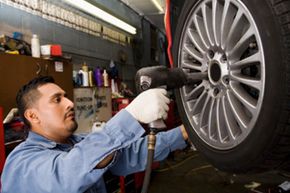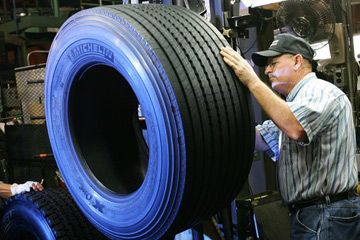Almost all car manufacturers recommend rotating a car's tires as part of a routine maintenance schedule along with oil changes, tune-ups, coolant and transmission flushes and fluid replacements. Their argument is simple and logical: Each tire on a car wears at a different rate, so in order to keep the wear relatively even and increase the life of the tire, they should be rotated. By extending life they specifically mean extending the life of the tire within its given limit.
This may have been the case when tires were relatively the same in construction and technology, differing little but in size. However, tires today come in a bewildering array of types, constructions, tread patterns -- and all are fitted on cars with very different needs.
Advertisement
Yet the physics affecting tires has remained the same. Heat is the bane of any tire. Think of a driver doing a burn-out, smoke pouring off the tires. When that smoke clears the tires have lost a lot of their life. The same happens on every car every time it moves -- heat is generated through friction and pressure, just on a far less dramatic scale.
The key point is that the generated heat is uneven. A front-wheel drive car will pull the car using the front tires, thereby generating more heat at that axle. Rear-wheel drive will do the opposite. This heat differential means there will be uneven wear between the front and rear.
Even more pointed is when a car turns. The front wheels, steering the vehicle, will wear faster than the rear wheels, which simply follow. Added to this is the turning radius. When a car makes a turn, each wheel goes through a slightly different arc at a slightly different speed, wearing at a slightly different rate.
Added to the above factors is braking, acceleration, road surface, the heat of the road surface and tires, tire pressure, tire composition, vehicle suspension and alignment angles, if the tire has scraped against a curb and if the rim was damaged by going through a pothole or hitting a bump.
Given the myriad of conditions it's almost a guarantee a car's tires will wear unevenly, and that rotation is a good idea. Yet these are the same arguments many people use to say tire rotation is a costly, and often unnecessary, part of auto maintenance.
That diverse group of wear factors, impossible to predict or control, means your tires will last as long as they last, regardless of whether they are rotated or not. Added to the critics' arguments are exactly how the tires are rotated and the relative effectiveness given the advanced construction and engineering of today's tires.
For example, the Chrysler Crossfire, a short-lived sports-luxury model, had different size tires in the front compared to the back, and rotation was possible only from side-to-side on each axle. Throw in directional tires with asymmetrical treads on a Crossfire and it wouldn't be possible to rotate the tires at all.
Yet rotation does serve a purpose. By moving tires to equalize wear, rather than simply allowing one section to wear while another remains pristine, will maximize the given life of a tire. Will it make your tire last longer? Yes, but only to the mileage it was rated for originally. A 60,000-mile (96,561-kilometer) tire run without rotation may last, say, 50,000 miles (80,467 kilometers). But with rotation there is good chance that same tire could reach 60,000 miles (96,561 kilometers), given the right conditions.
In the end, it can be determined that tire rotation is a good idea in that it provides a better and safer ride for the car's occupants -- even if it may not necessarily make the tires last a whole lot longer.
For more information about tire rotation and other related topics, follow the links on the next page.
Advertisement



